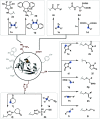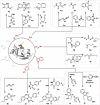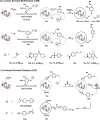D is in tegrate (DIN) Theory Enabling Precision Engineering of Proteins
- PMID: 36844488
- PMCID: PMC9951294
- DOI: 10.1021/acscentsci.2c01455
D is in tegrate (DIN) Theory Enabling Precision Engineering of Proteins
Abstract
The chemical toolbox for the selective modification of proteins has witnessed immense interest in the past few years. The rapid growth of biologics and the need for precision therapeutics have fuelled this growth further. However, the broad spectrum of selectivity parameters creates a roadblock to the field's growth. Additionally, bond formation and dissociation are significantly redefined during the translation from small molecules to proteins. Understanding these principles and developing theories to deconvolute the multidimensional attributes could accelerate the area. This outlook presents a disintegrate (DIN) theory for systematically disintegrating the selectivity challenges through reversible chemical reactions. An irreversible step concludes the reaction sequence to render an integrated solution for precise protein bioconjugation. In this perspective, we highlight the key advancements, unsolved challenges, and potential opportunities.
© 2023 The Authors. Published by American Chemical Society.
Conflict of interest statement
The authors declare no competing financial interest.
Figures









References
-
- Vasta J. D.; Peacock D. M.; Zheng Q.; Walker J. A.; Zhang Z.; Zimprich C. A.; Thomas M. R.; Beck M. T.; Binkowski B. F.; Corona C. R.; Robers M. B.; Shokat K. M. KRAS Is Vulnerable to Reversible Switch-II Pocket Engagement in Cells. Nat. Chem. Biol. 2022, 18 (6), 596–604. 10.1038/s41589-022-00985-w. - DOI - PMC - PubMed
Publication types
LinkOut - more resources
Full Text Sources
Miscellaneous

